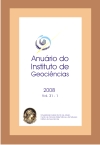Psammic cyanobacteria in marginal sediments of Rodrigo de Freitas lagoon, Rio de Janeiro State, Brazil
DOI:
https://doi.org/10.11137/2008_1_43-49Abstract
The Rodrigo de Freitas lagoon is a brackish aquatic body, lies within the coordinates 22º57'02"- 22º52'09" S and 43º11'09" -43º13'03" W, in the Rio de Janeiro State. The psammic cyanobacteria live in the surface of the sediment and between the clastic grains, mainly quartz. The objective of the present study was identification of the psammic cyanobacteria found in the marginal portion of the lagoon and the determination of physical -chemical parameters (dissolved oxygen, salinity, temperature of the water and sediment and pH) in the places of sampling of the psammic cianobacteria. Sampling during the year of 2007 had been carried through, in the period of ebb tide of the lagoon, where five sample stations had been established. The taxonomic analisys was made with fresh and permanent slides, through optic microscope mensuration, that allowed to observe its classic morphological characteristics. The families Chroococcaceae Nägeli 1849 and Synechococcaceae Komárek & Anagnostidis 1995 is most frequent, for 41% and 18,2% respectively of the joined species. The other observed families presented the following percentages: Phormidiaceae Anagnostidis & Komárek 1988 with 13,4%; Entophysalidaceae Geitler 1925; Schizothrichaecae Anagnostidis & Komárek 1988; Oscillatoriaceae former (Harvey) Kirchener 1898 and Nostocaceae Kutzing 1943 each one with 4,5%Downloads
Download data is not yet available.
Downloads
Published
2008-01-01
How to Cite
Magina, F. C. and Silva, L. H. da S. e (2008) “Psammic cyanobacteria in marginal sediments of Rodrigo de Freitas lagoon, Rio de Janeiro State, Brazil”, Anuário do Instituto de Geociências. Rio de Janeiro, BR, 31(1), pp. 43–49. doi: 10.11137/2008_1_43-49.
Issue
Section
nd1569639953
License
This journal is licensed under a Creative Commons — Attribution 4.0 International — CC BY 4.0, which permits use, distribution and reproduction in any medium, provided the original work is properly cited.















